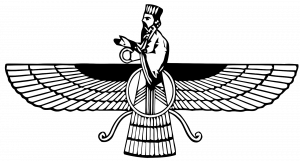Cyrus II, the first king of the Achaemenid Empire, reigned for over thirty years, necessitating him to make decisions and regulations regarding the religions of the vast populace in his care. His religion, religious tolerance, and religious depictions reflect the beliefs of the empire upon which he ruled.
Cyrus’ Religion
Several contemporary scholars speculate that Cyrus followed the teachings of Zoroastrianism, the first religion that dominated the Persian empire. This claim is affirmed by Mary Boyce, an expert on Iranian languages and Zoroastrianism, as well as the Zoroastrian Association of Greater New York. The religion amassed many believers in the Persian empire amid the 6th century and goes by the teachings of the prophet Zoroaster and worships Ahura Mazda as its supreme ruler, emphasizing the duality between good and evil. Zoroaster forwarded the practice of performing universal good deeds that would favor Ahura Mazda, such as being honest and charitable to others.
Skeptics of Cyrus’ status as a Zoroastrianism believer mention that contemporary sources have not explicitly stated this as his religion. Furthermore, his decree which allowed the Christians to return to their homeland after being held captive in Babylon showed that the Persian king acknowledged the Babylonian deity Marduk. The decree had writings expressing that Marduk chose Cyrus to take over Babylonia after the tyrant Nabonidus described in the Bible during his harsh invasion of Judea. Cyrus also offered sacrifices to other gods of the Babylonian empire, such as Naboo.
Additionally, the Greek historian Xenophon wrote that Cyrus made a promise to the Iranian god of oaths named Mithra, which could mean that he worshiped the traditional Iranian gods. These texts lead many historians to conclude that Cyrus was polytheistic, believing or acknowledging the gods of the places he colonized.
Religious Tolerance
Cyrus’ most well-known decree, the Cyrus Cylinder, indicated that he practiced or encouraged religious tolerance. The ancient clay artifact holds Akkadian cuneiform inscriptions describing Cyrus’ order to repatriate the displaced peoples in Babylonia, freeing the Jews from their 70 years of captivity initiated by the Babylonian king Nebuchadnezzar. Other prisoners of war were also released after the issuing of the decree as the cylinder documented Cyrus’ accepting nature regarding the diverse peoples in his empire.
In the Book of Ezra in the Bible, it was shared that over 50,000 Jews were provided money and resources to rebuild their temple in Judah from the royal treasury, an act that showed Cyrus’ support of the Jews in their efforts to raise their hometown once again.
Cyrus’ religious tolerance contrasted the authoritative rule of previous Neo-Assyrian and Neo-Babylonian kings that reigned in the areas he conquered. The Greek historian Herodotus expressed that Cyrus was called “The Father” by the Iranians due to his gentle and accepting manner and policies.
Biblical experts used the clay form to prove the Persian king’s decision to allow the Jews to return to Jerusalem and build a temple. The Cyrus Cylinder was of great interest to the public at the end of the 1960s due to the last Shah of Iran dubbing it “the world’s first charter of human rights.”
Presence in Religious Texts
Cyrus was mentioned in the Hebrew Bible as the Persian king and the “anointed one” to liberate the Jews from Babylonian captivity. He was mentioned more than 23 times in the Old Testament through the books of Daniel, Chronicles, Isaiah, and Ezra. In addition to this, the Quran is also believed to have an account of Cyrus under the name of Dhul-Qarnayn, while others suppose that the character references Alexander the Great instead.
